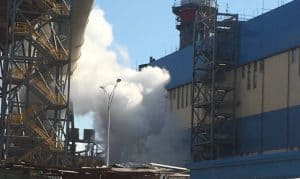Clean with steam
During the construction of new power plants, it is impossible to prevent unwanted matter from remaining in the steam and water cycle. In addition to unwanted matter, the various systems will be contaminated with corrosion products (iron oxides) that are caused by the heat input into the material during the construction process (annealing) and / or rust due to environmental factors.
Save costs
To remove these unwanted matter and corrosion products, a boiler is steam blown before the steam is fed to the steam turbine. It is advisable to carry out a chemical acid cleaning prior to steam blowing, in order to shorten the number of required steam blowing cycles. Huge time and cost savings can be achieved with this (time, demineralised water, gas / fuel).
The power of steam
Steam blowing is a cleaning method where the power (energy) and speed of steam in the system (K-factor) are used to remove impurities from boiler parts and extra pipelines. The temperature differences during steam blowing will remove the mill scale due to expansion and contraction of the steam pipes.
Check
During the steam blowing cycles, prepared (copper) plates, so-called "target plates", are placed in the temporary system on which the released contamination strikes. Depending on the number and size of particles on the mirror plate, the steam blowing must be continued until the impacts fall within the specified criteria.
Noise reduction
The release of steam into the atmosphere with the required, large amounts of energy, produces a lot of fog and noise. To reduce the noise levels to acceptable values, steam must be cooled by condensation.
There are two methods to suppress the noise:
- One is the classical silencer or knock out pot, which works like a type of cyclone; the increasing of the surface area will cool the steam. This noise reduction method is used for the discontinuous steam blowing.
- The second type works by means of a water injection system (quenching system) that condenses the steam and can be partially collected for reuse during steam blowing. This noise reduction method is used for continuous steam blowing.
Methods of steam blowing
The two most common methods of steam blowing are:
The continuous steam blowing has several advantages over the discontinuous steam blowing. These advantages are not only limited to the possibility of achieving the K-factor for a longer period of time, but also the system load is within the design parameters and the noise level is limited through water injection to below <90dB.
Due to its many advantages, the continuous steam blowing method is the preferred method by Vecom.
Vecom has the know-how and the materials
Vecom has invested in equipment and expertise for steam blowing.
This equipment consists of:
- Quench water (spray water) silencer;
- Storage tank for demineralised water supply (30 m3) and pumps suitable for high temperatures;
- Condenser pot;
- Temporary steam blow piping (up to DN450);
- Automatic target inserters.
